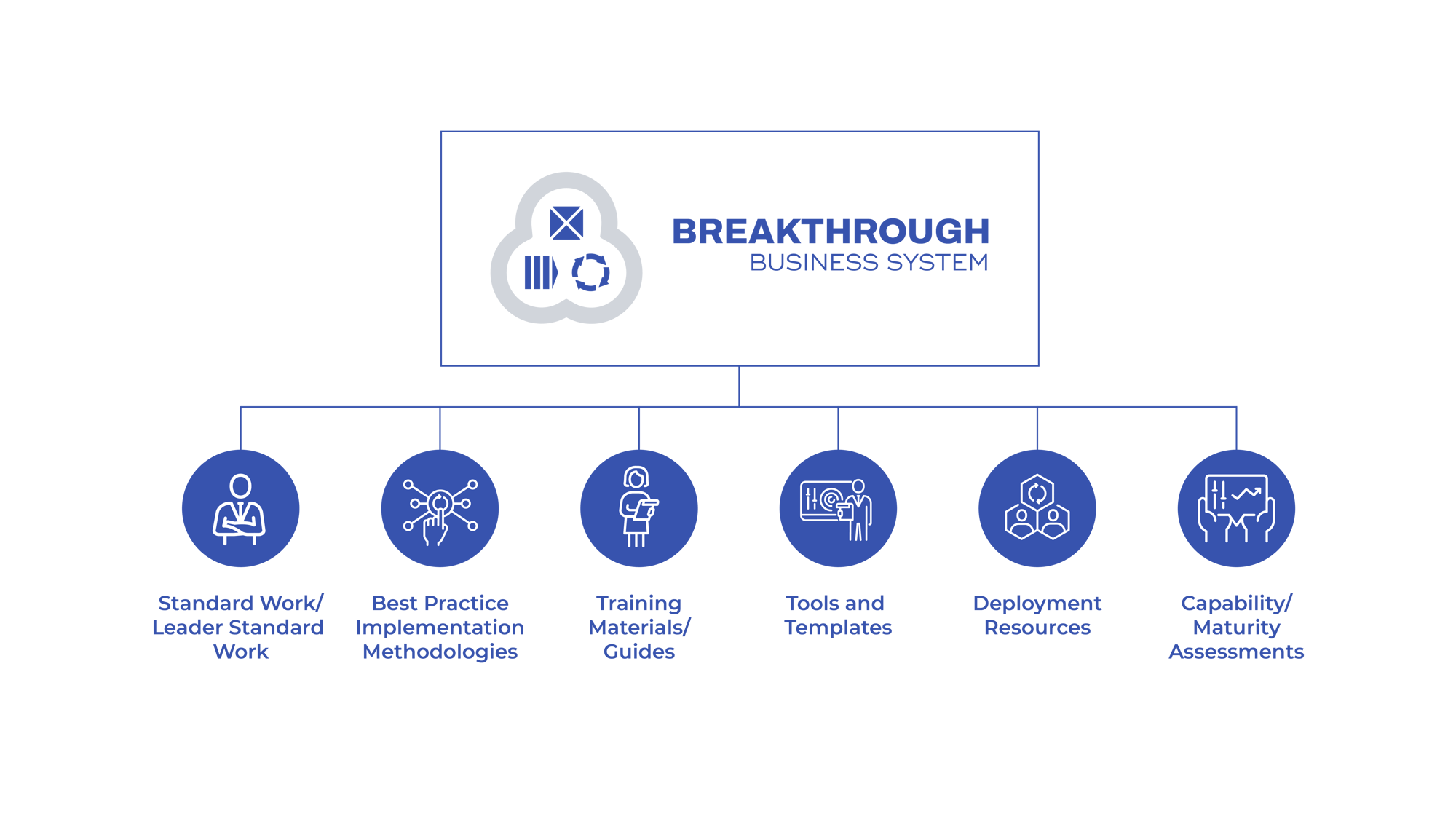THE BREAKTHROUGH BUSINESS SYSTEM
A world-class lean business system ready for you to brand and customise.
Finally, a Better Alternative…
If you’re contemplating developing a lean business system for your organisation or recognise the need to upgrade or refresh your existing system, then there is finally a better alternative to the costly, time-consuming and frankly risky process of doing it yourself and/or starting from scratch.
A product of over two decades of close study of 40+ industry leading lean business systems, the Breakthrough Business System is a world-class lean business system template that you can rapidly make your own.
How Can You Make the Breakthrough Business System Your Own?
01.
Assess The Fit
The fastest way to assess whether the Breakthrough Business System could be an option for your organisation is to schedule a guided demo with one of our business system experts. In around 90 minutes you’ll not just see what’s “in the box” but also examples of the use of the system in a fictional (but representative) large enterprise.
02.
Kick the Tyres
In Breakthrough Partners we believe that you need to go to the “Gemba” to really understand anything. In this case the “Gemba” is the 140+ resources that collectively comprise the Breakthrough Business System. To make it easy to do this we offer a free 30 Day trial in which you can thoroughly review all of the resources and decide if our system could work for you.
03.
Customise the System
A highly modular design means you can choose and integrate only the components of the system you need. A comprehensive guide to customising the system walks you through the customisation options and the key decisions needed to ensure system reflects your organisation’s unique operating model, cadences, language, values and culture.
04.
Brand the System
All Breakthrough Business System materials have been designed to make it easy to apply both organisational and system level branding. Our experience is that giving your organisation’s business system a clear identity and aligning the materials to your organisations brand is critical to the system being adopted as “your” business system.
With the Breakthrough Business System, you can be confident that the standards, tools, methodologies and templates are battle-tested, consistent, effective and reflect contemporary best practices.

The Origin of the Breakthrough Business System
Hear from Paul Docherty, Breakthrough Partners’ founder, are he explains the “ah ha” moment that led to the development of the Breakthrough Business System.
Why Leverage the Breakthrough Business System?
◢ Reduce Risk
Lean Enterprise Institute research suggests that less than 20% of organisations that embark on implementing Lean reach the point it’s a fully self-sustaining system. Our experience of the many pitfalls our clients have faced implementing lean corroborates this.
It doesn’t have to be this way. The best practice methods integrated within the Breakthrough Business System have been designed to mitigate the primary failure modes we have observed time and time again in those organisations that struggle to make lean stick.
More than just reducing the overall risk of failure of the initiative, the leveraging the Breakthrough Business System will also protect your organisation from other serious risks such as infringement of intellectual property.
◢ Reduce Cost and Effort
Our research suggests that the average cost to implement an enterprise lean business system from scratch is in the order of $3M.
In reality, this is never just a question of the financial investment – to build an effective business system takes scarce “know how” that you either have to find in the market, or free up (if you have it) from the job of driving and supporting improvement. Like all things, there are much larger hidden costs of building your own system, that, to use the iceberg analogy, lie unseen under the water.
On average, our clients have estimated the cost of leveraging the Breakthrough Business System to create/augment their system to be a small fraction (10-20%) of the costs of doing it themselves.
◢ Reduce Time to Value
KPMG research suggest that organisations implementing lean typically progress through multiple levels of Lean maturity (and frequently multiple cycles of learning) before reaching the point it becomes a self-sustaining system. They estimate that it typically takes 8-10 years to reach the tipping point where the system is consistently generating “year on year” productively improvements. Other experts estimate this time to be longer.
Our research suggests the median time to build and deploy a lean business system (at an enterprise level) is 3-5 years. Our experience is that by leveraging the Breakthrough Business System and our proven “model and replicate” deployment model this can be reduced to less than 2 years. This time saving can translate in larger organisations in tens, if not hundreds of millions of dollars in value unlocked years earlier than it otherwise would be.
◢ Faster and Better Adoption
Getting buy-in from across your organisation to an internally developed business system – particularly one that is constructed by trying to harmonise different approaches that have taken root over time in different parts of larger organisation can be a time consuming, and frustrating, process.
Our client’s experience is that encouraging stakeholders to brand, customise and build on what is already a contemporary, coherent, complete and proven system brings faster alignment and greater commitment. This approach avoids “winners and losers”, minimises organisational politics and paradoxically reduces the “not invented here” resistance that plagues the adoption of home-grown systems that almost inevitably end up favouring one division/unit’s system over another.
Additionally, this approach avoids the risk that buy-in is reduced by a system which is incoherent and doesn't, from the point of launch, consistently reflect the brand identity and culture of the organisation.
What’s in the Breakthrough Business System?
Comprising over 150 road-tested resources that are designed to work as an integrated system, the Breakthrough Business System provides all of the standards, templates, tools and assessments you need to run, improve and transform the business as well as proven methodologies, deployment resources and other supporting materials you need to implement and deploy the system in your organisation.

▶ Standard Work and Leader Standard Work
At the core of all Lean Business System are standards. Like the standards we use to consistently produce products and services, we need standards to define how we run, improve and transform the organisation.
From ready to use standard work for all operational and strategic planning, execution and review processes to leader standard work templates for all supervisory roles, the Breakthrough Business System includes all the standards you’ll need to establish a robust lean business system.
▶ Best Practice Implementation Methodologies
At the heart of the Breakthrough Business System are a set of robust and proven methodologies to implement a Lean based production system and/or a Hoshin or OKR based breakthrough system.
Included in the Breakthrough Business System are all of the resources (communication/ workshop materials, facilitator guides, template plans, facilitator and line training materials etc) that an internal facilitator would need to successfully implement each of the methodologies.
▶ Training Materials and Guides
In addition to the “apply at point of use” training embedded into the methodologies, the Breakthrough Business System includes a full suite of Lean, Hoshin, OKR and Agile training modules designed for both facilitators and to build capability in the wider organisation.
Fully aligned with the standard work and implementation methodologies and including Breakthrough Partners innovative suite of Learn@ScaleTM experiential learning simulations, these materials provide everything you need to establish an internal academy for your organisation’s Lean Business System.
▶ Tools and Templates
Included in the Breakthrough Business System are a comprehensive and coherent suite of tools and templates that support both planning and implementation of specific best practices as well as the standard work those practices establish to run, improve, and transform the organisation.
From templates to support implementation of Lean, Hoshin Kanri, OKRs and Agile to templates that support daily front-line problem solving all the way to templates that support the annual strategy refinement, deployment and execution cycle the Breakthrough Business System has all the templates you’ll need to support your organisation’s lean business system.
▶ Deployment Resources
Included in the Breakthrough Business System are a comprehensive and coherent suite of tools and templates that support both planning and implementation of specific best practices as well as the standard work those practices establish to run, improve, and transform the organisation.
From templates to support implementation of Lean, Hoshin Kanri, OKRs and Agile to templates that support daily front-line problem solving all the way to templates that support the annual strategy refinement, deployment and execution cycle the Breakthrough Business System has all the templates you’ll need to support your organisation’s lean business system.
▶ Capability and Maturity Assessments
In addition to the “apply at point of use” training embedded into the methodologies, the Breakthrough Business System includes a full suite of Lean, Hoshin, OKR and Agile training modules designed for both facilitators and to build capability in the wider organisation.
Fully aligned with the standard work and implementation methodologies and ncluding Breakthrough Partners innovative suite of Learn@ScaleTM experiential learning simulations these materials provide everything you need to establish you internal Lean Business System academy.
Case Study
Molex, a Koch Company
A global leader in the manufacture of electronic, electrical, and fiber optic connectivity systems, Molex’s 38,000 employees operate in 38 countries producing 100,000+ products with the collective goal of creating connections for life.
In 2018, Molex embarked on the development and global deployment of a new lean business system – christened the Molex Operating System. They evaluated options to develop this system in-house or to adapt an existing 3rd party system.
In the end, as Scott Nelson, the executive who led the deployment of the Molex Operating System put it, “the decision was easy – adopting the Breakthrough Business System cut years off our time to value and allowed us to deploy a new foundational daily management system for a fraction of the cost it would have taken us to do it in-house.”
Now the standard across the majority of Molex 100+ manufacturing facilities, the Molex Operating System is enabling new levels of operational efficiency and helping Molex set a new standard for excellence in their industry.
❝In the end, the decision was easy – adopting the Breakthrough Business System cut years off our time to value and allowed us to deploy a new foundational daily management system for a fraction of the cost it would have taken us to do it in-house.❞
Scott Nelson, Director, Operational Excellence, Molex

Whether You Want to Improve Your Game or Change the Game Breakthrough Partners Can Help
Navigate the Change
Learn how Breakthrough Partners can help you build, and remove barriers to, the individual, team and organisational adaptability needed to thrive in an ever more disrupted and hyper-connected world.
Explore Our Training
Explore the options we offer to help build the skills and know how you need to successfully implement and sustain your organisation's lean business system.

